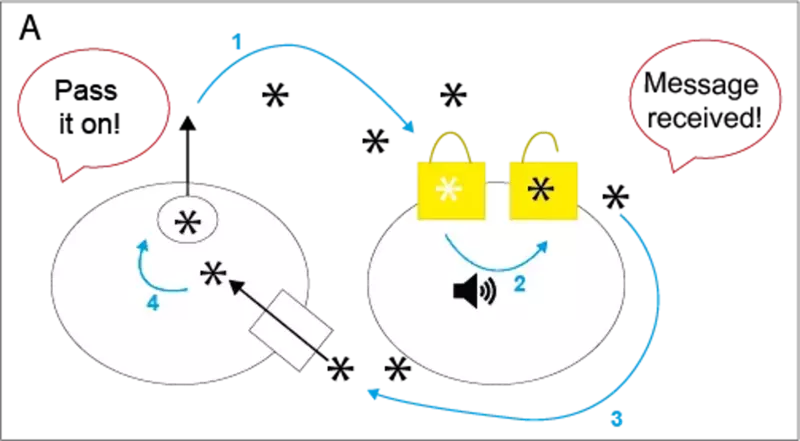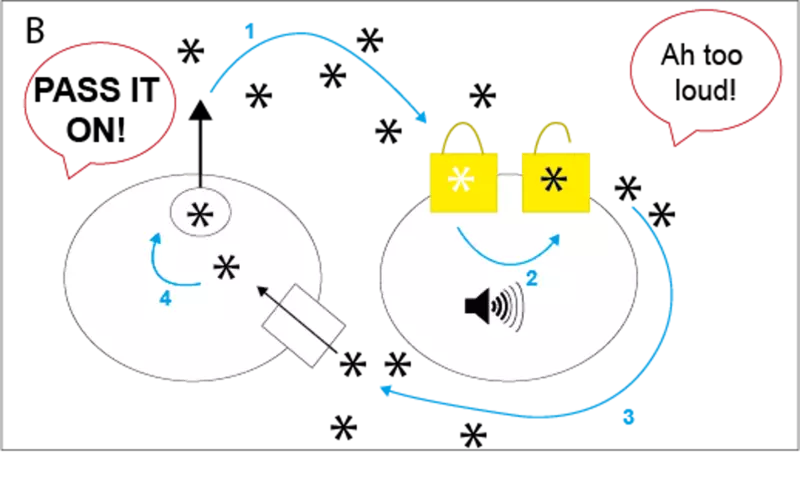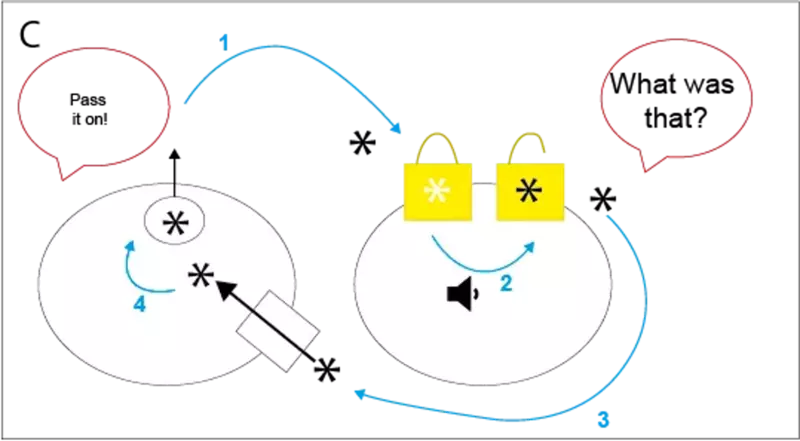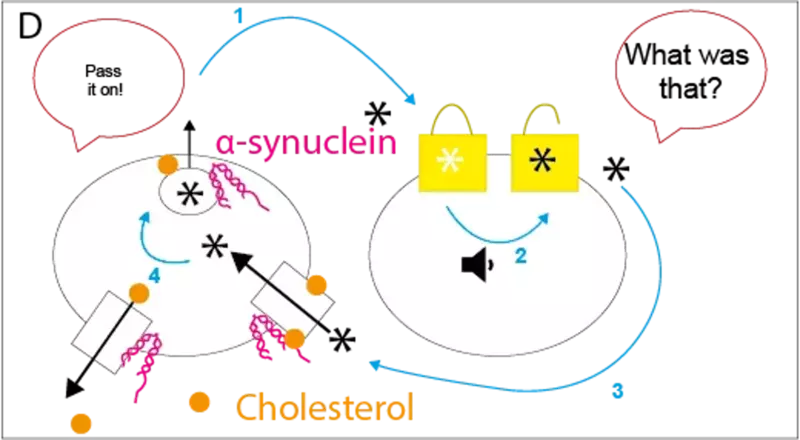Bridging the gap between basic research and people with Parkinson’s
My name is Katherine Brimblecombe and I am a neuroscientist at the University of Oxford, funded by Parkinson’s UK, researching the mechanisms that control dopamine release. I want to use this blog to share and explain our latest research results.
Why does Parkinson’s UK fund my research?
The main reason people with Parkinson’s have problems moving is because a group of brain cells die. The brain cells that die are supposed to release a chemical called dopamine.
The reason dopamine-producing cells die in people with Parkinson’s seems to have a lot of causes, meaning it’s still unclear as to why some people get Parkinson’s. But researchers have some clues, for instance, the substance alpha-synuclein often seems to be a factor. We are still trying to understand what alpha-synuclein normally does in a cell to help it work, and why in Parkinson’s it stops helping and starts hurting the dopamine-producing-cells.
Much of my work is trying to understand why some areas of the brain that release dopamine are so vulnerable in Parkinson’s. To answer these questions most of my research measures dopamine release from slices of mouse brain.
In this blog, I will outline the latest results from my research and why I feel so passionately about communicating in a way everyone can understand.
Read the full accessible paper
To find out more about our research, you can find my accessible version on the University of Oxford's Department of Physiology, Anatomy and Genetics website.
You can also read the glossary on the University of Oxford's Department of Physiology, Anatomy and Genetics website.
View the full peer-reviewed open-access manuscript on the Frontiers website.

A bit about me
As well as being a neuroscientist, I am also the mum of 2 boys. My youngest son has a very rare genetic condition. As I’m sure many of those within the Parkinson’s community can appreciate, I benefit enormously from online support groups. Many of the members of these groups (myself included) are incredibly dedicated to following the scientific literature around their children’s conditions.
Whilst reading scientific literature about my son’s condition, I became aware of how distressing and isolating it is to be communicated to in a language you can’t engage with. I would hate for my research to make people with Parkinson’s feel this way, so I set myself the challenge to write an accessible version of our recently published scientific paper for the Parkinson’s community.
Turning science into English
The first issue I came up against was the concept of 'specialist knowledge'. I know how quickly us researchers slip into using jargon, but I was worried about being condescending to the hugely knowledgeable Parkinson’s community. I initially discussed some ideas with friends and family and realised that often the biggest barrier to overcome is confusing terminology. So to accompany the accessible version of our research results, I wrote a glossary to help explain technical terms or offer alternative language to help readers follow the research.
I was also keen to produce more than just a summary of the key results, offering a full explanation of our findings and the process of getting there.
Reflecting on the progress of our research, from our initial observations and hypotheses to its final publication was very rewarding. It’s easy to feel exhausted by the time you submit a paper and just want it to go away! However, distilling and simplifying your findings is a great way to find the boundaries of your understanding, and helps to reconnect with your key questions.
Our results explained: How alpha-synuclein changes the comings and goings of dopamine
Sending messages in the brain
In the brain, cells talk: sending messages to each other by releasing chemicals that fit like keys into special locks called receptors on their neighbouring cells. Dopamine is one of these chemicals.
The volume of these messages is controlled by changing the amount of chemical released or how quickly it is taken away.
There is special machinery that sits on the surface of brain cells that controls the movement of dopamine in and out of the cells. One part of this machinery is a special carrier called the dopamine transporter which moves dopamine from outside of the cell back inside. This transporter is also linked to the machinery that controls the release of dopamine, and therefore it plays a vital role in controlling how much dopamine is available to send messages to neighbouring cells.
Let’s use some diagrams to help visualise this

A. This picture shows how dopamine (shown as an asterisk) is released from the first cell (1), and floats to its neighbouring cell where it unlocks the receptor to pass on a message (2).
After the receptor has been unlocked, dopamine can float off the receptor and back to the first cell where it is taken back up by the dopamine transporter (shown as a rectangle) (3). When back inside the cell, dopamine can be recycled so it’s ready to send its next message.

Messages between cells must be sent at the right volume.
B. If too much dopamine is released (1) or it’s not taken away fast enough (3) the message received by the neighbour cell is too loud (2).

C. If not enough dopamine is released (1) or it’s taken away too quickly (3) the message received by the neighbour is too quiet (2).
What were the aims of our research?
We know these messages are disrupted in Parkinson’s leading to some of the symptoms of the condition. Our research aimed to shed some light on what might be happening in Parkinson’s to disrupt these conversations between cells.
We had previously noticed that in mice that make lots of alpha-synuclein there is less dopamine around to talk to their neighbouring cells. We knew that these mice didn’t have a lack of dopamine inside brain cells, so we wanted to understand if the problem was because the dopamine cells release less dopamine or if the dopamine is taken away too quickly. Both of these reasons would offer an explanation for the lower levels of this important chemical.
What did our research find?
We found that in mice that make a lot of alpha-synuclein the dopamine transporter is working too well and is lowering the amount of dopamine being available to play their vital role. In these mice, the dopamine transporter carries dopamine away faster and stops as much dopamine from being released, meaning there is less dopamine around to talk to other cells for a shorter amount of time: a double whammy! Just like what’s happening in Diagram C.
The next question was to understand how alpha-synuclein might be changing the dopamine transporter.
We found that alpha-synuclein changes the volume of the message by increasing the amount of cholesterol (orange blob) being carried outside of the cell. When outside of the cell, cholesterol makes the dopamine transporter work too well, carrying the dopamine away too quickly and stopping as much dopamine from being released in the first place.

D. Our new data shows how alpha-synuclein (pink squiggles) can make the message too quiet (2), by reducing the amount of dopamine released (1) and by increasing how quickly the dopamine transporter carries dopamine back inside the cell (3).
What impact does this research have?
Understanding these steps gives us more opportunities to target and design therapies that might help to improve how cells communicate in Parkinson’s. Understanding the earliest stages of the condition will give us a better chance to find therapies and targets that might be able to slow or stop symptoms of Parkinson’s from developing.
Working together
Collecting the data was a real team effort with many people contributing from different groups. Without their specialist knowledge it wouldn’t have been possible to answer our questions. Many of the scientists who contributed did so simply because we asked them to. They took time out of their own research questions to help us out, and for me, this is science at its best!
Get connected
Join our Research Support Network to make sure you never miss a breakthrough or an opportunity to get involved in Parkinson's research. Sigh up and start receiving email updates today.

